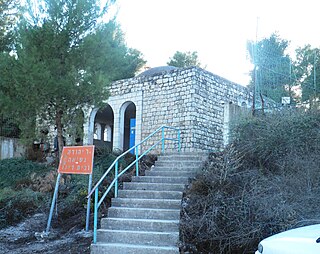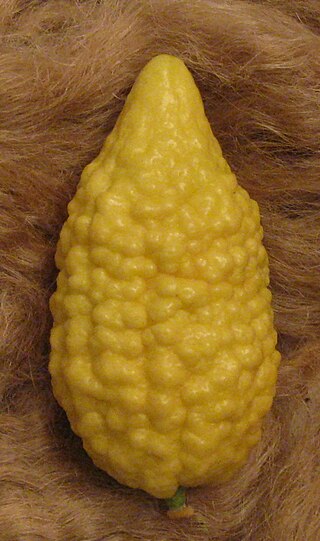Related Research Articles

Tiberias is an Israeli city on the western shore of the Sea of Galilee. A major Jewish center during Late Antiquity, it has been considered since the 16th century one of Judaism's Four Holy Cities, along with Jerusalem, Hebron, and Safed. In 2022, it had a population of 48,472.

The Sanhedrin was a legislative and judicial assembly of either 23 or 71 elders, existing at both a local and central level in the ancient Land of Israel.
Yohanan ben Zakkai, sometimes abbreviated as ריב״ז ribaz for Rabbi Yohanan ben Zakkai, was a tanna, an important Jewish sage during the late Second Temple period during the transformative post-destruction era. He was a primary contributor to the core text of Rabbinic Judaism, the Mishnah. His name is often preceded by the honorific title Rabban. He is widely regarded as one of the most important Jewish figures of his time, and his escape from the Roman destruction of Jerusalem may have been instrumental in Rabbinic Judaism's survival post-Temple. His tomb is located in Tiberias within the Maimonides burial compound.
Johanan bar Nappaha was a leading rabbi in the early era of the Talmud. He belonged to the second generation of amoraim.

Judah II or Nesi'ah I was a Jewish sage who lived in Tiberias in the Land of Israel, in the middle of the third century CE.

Isaiah or Yeshayahu ben Avraham Ha-Levi Horowitz, , also known as the Shelah HaKaddosh after the title of his best-known work, was a prominent rabbi and mystic.
Rabbi Yisroel Halpern, also known as Yisroel Karduner born circa 1850, was a Breslover Hasid who lived in Ottoman Palestine at the turn of the century.

Baruch Shalom HaLevi Ashlag was a kabbalist, the firstborn and successor of Yehuda Ashlag also known as Baal Hasulam, the author of "The Sulam" commentary on the Zohar. Among his writings: Shlavey ha Sulam, Dargot ha Sulam, Igrot Rabash.
Rabbi Meir was a Jewish sage who lived in the time of the Mishnah. He was one of the Tannaim of the fourth generation (139-163). He is the third most frequently mentioned sage in the Mishnah and is mentioned over 3,000 times in the Babylonian Talmud. His wife Bruriah is one of the few women cited in the Gemara.

Slonim is a Hasidic dynasty originating in the town of Slonim, which is now in Belarus. Today, there are two Slonimer factions. Slonim, based in Jerusalem, and the Slonim community in Bnei Brak. They are two distinct groups today, and have many differences between them.
The halukka, also spelled haluka, halukkah or chalukah was an organized collection and distribution of charity funds for Jewish residents of the Land of Israel.

Moses ben Joseph di Trani the Elder, known by his acronym Mabit was a 16th-century rabbi in Safed.

The balady citron is a variety of citron, or etrog, grown in Israel and the West Bank, mostly for Jewish ritual purposes. Not native to the region, it was imported around 500 or 300 BCE by either Jewish or Greek settlers. Initially not widely grown, it was promoted and popularized in the 1870s by Rabbi Chaim Elozor Wax.
The Old Yishuv were the Jewish communities of the region of Palestine during the Ottoman period, up to the onset of Zionist aliyah waves, and the consolidation of the new Yishuv by the end of World War I. Unlike the new Yishuv, characterized by secular and Zionist ideologies promoting labor and self-sufficiency, the Old Yishuv primarily consisted of religious Jews who relied on external donations (halukka) for support.

According to Jewish tradition, the Tomb of Maimonides is located in Tiberias, Israel. Although Maimonides, a Sephardic Jew, died in Fustat, Egypt, on 12 December 1204, it is believed that he was only briefly buried in Fustat before being reinterred in Tiberias. Owing to his recognition as a prominent Jewish philosopher, his tomb is one of Israel's most important Jewish pilgrimage sites and is also among Tiberias' most visited tourist attractions. The site also serves as the burial place of Yohanan ben Zakkai, a prominent Tanna of the Second Temple period; and Isaiah Horowitz, a prominent Jewish mystic of the 16th/17th century.
The history of Palestinian rabbis encompasses the Israelites from the Anshi Knesses HaGedola period up until modern times, but most significantly refers to the early Jewish sages who dwelled in the Holy Land and compiled the Mishna and its later commentary, the Jerusalem Talmud. During the Talmudic and later Geonim period, Palestinian rabbis exerted influence over Syria and Egypt, whilst the authorities in Babylonia had held sway over the Jews of Iraq and Iran. While the Jerusalem Talmud was not to become authoritative against the Babylonian Talmud, the liturgy developed by Palestinian rabbis was later destined to form the foundation of the minhag Ashkenaz that was used by nearly all Ashkenazi communities across Europe before Hasidic Judaism.

The wife of Rabbi Akiva was a late 1st-century CE Jewish resident of Judea who is cited by the Talmud and Aggadah as a paragon of the Jewish wife who encourages her husband to pursue Torah study and is willing to make personal sacrifices to achieve that goal. She was the wife of the Tanna Rabbi Akiva, who became one of the greatest Torah scholars in Jewish history. She played a significant role in encouraging Akiva to pursue Torah study, as he was uneducated when they married. Her father, the wealthy ben Kalba Savu'a, disowned her over her choice of husband, and the couple lived in dire poverty. With her blessing, Akiva left to study in a Torah academy for 24 years. He returned home a renowned scholar accompanied by 24,000 disciples. When she came out in ragged clothing to greet him, his disciples tried to push her aside. Akiva told them, "Leave her. What is mine and what is yours is hers". Upon seeing his son-in-law's Torah scholarship, ben Kalba Savu'a reconciled with him and gave him half his wealth. Later Akiva had a special golden diadem fashioned for his wife, depicting the city of Jerusalem.
Bethmaus, or Beth Maʿon, also called Maon, was a Jewish village during the late Second Temple and Mishnaic periods, and which was already a ruin when Kitchener visited the site in 1877. It was situated upon the hill, directly north-west of the old city of Tiberias, at a distance of one biblical mile, rising to an elevation of 250 metres (820 ft) above sea-level. It is now incorporated within the modern city bounds of Upper Tiberias. The remaining structure built over the site is a Sheikh's Tomb.
Hananiah ben Akavia was a rabbi of the second century.
Rabbi David ben Levi of Narbonne was a Talmudist of the late 13th century, best known as author of Sefer haMichtam.
References
- 1 2 Gottlieb, Samuel Noah (1912). Ohalei Shem Pinsk: M. M. Gleiberman. p. 490.
- ↑ Halperin, Raphael (1985). Atlas Eytz Chayim. Tel Aviv: Heḳdesh Ruaḥ Yaʻaḳov. p. 178.
- ↑ Gaon, Moses David (1928). Yehude ha-mizrah be-Erets Yiśraʼel. Jerusalem: Ezriel. p. 210.